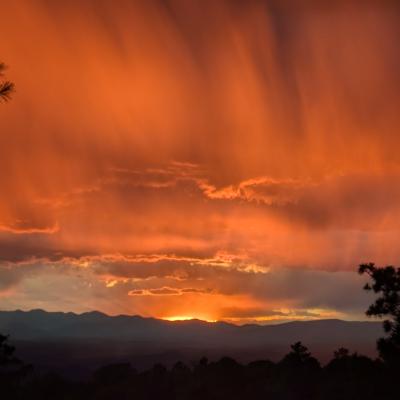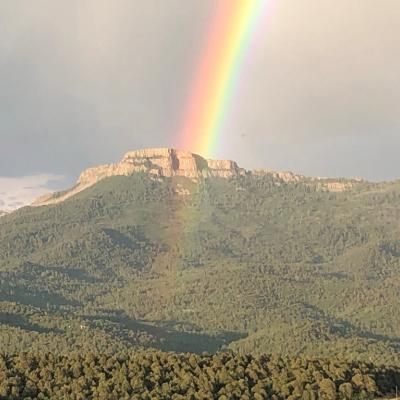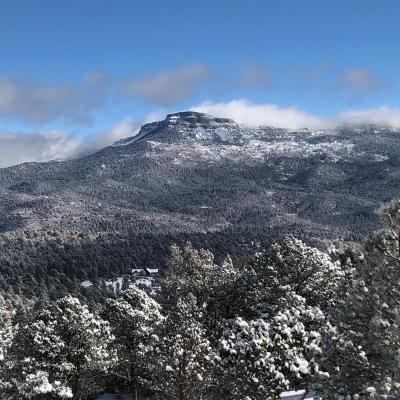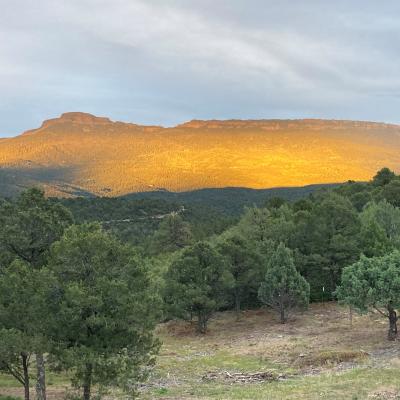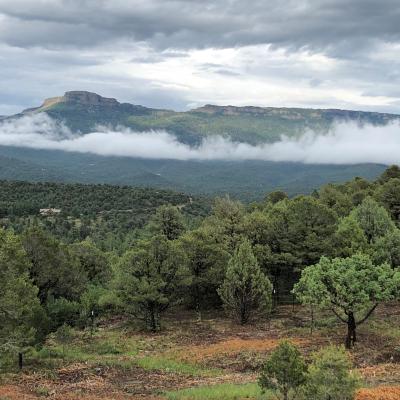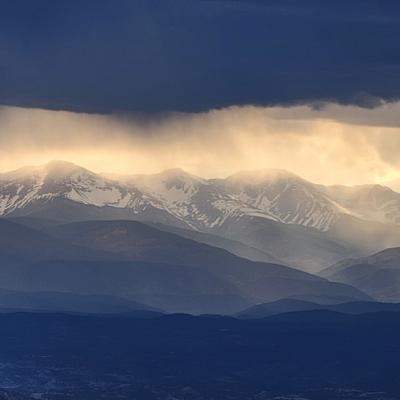Feeding Wildlife. Don't Do It !
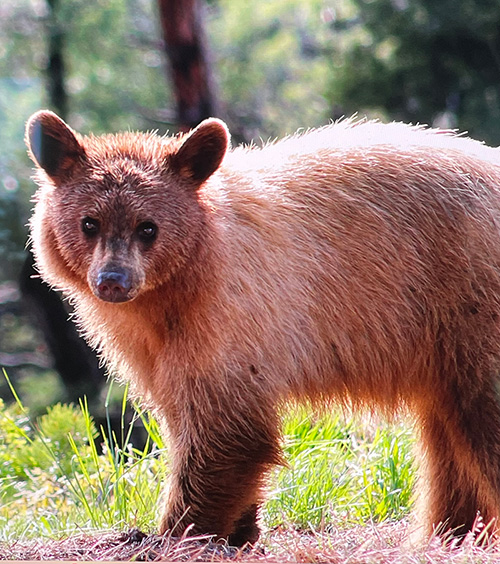

Wildlife. Please Don't Feed !
Feeding Wildlife. Don't !
By Carol Rawle
It was August, 1995. I had just moved into my newly built home on the Santa Fe Trail Ranch the week before. I had just finished a bracing breakfast of buttermilk pancakes and left the uneaten portion on the kitchen counter to cool, then got into my truck to go gather rocks for a retaining wall I was building at the rear of my house. I returned ten minutes later with a load of rocks, and noticed the fern that had been hanging over the kitchen sink was now on the front porch.
Absolutely clueless, I got out of the truck, walked onto the porch and stared at the broken pot, then noticed the window screen was not on the kitchen window, but crumpled nearby. Getting a rather alarming vibe, I went over to look in another window and saw a black bear staring back at me from my living room. I took advantage of the bear running into another room to open the front door and prop the screen door open. Then I got out of there in hopes the bear would discover the open door and leave.
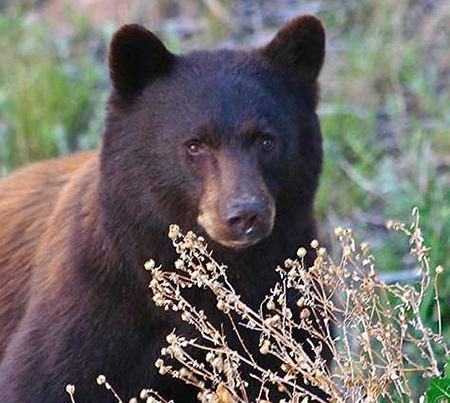 Fifteen minutes later, I returned and I carefully inspected each room, hoping I didn’t run into the bear. The bear had left, but my next shock was the amount of damage the bear managed to do in those ten minutes it was inside. It had pulled every drawer out onto the floor in the kitchen, as well as the contents of the freezer and spice cupboard. House plants were dumped on the floor, potting soil scattered all over. The drapes in the bedroom were pulled down, and a bottle of shampoo was half eaten in the bathtub. The tub now sported bear claw marks in the porcelain. Similar claw marks, which still exist thirty years later, were on the kitchen stove and window sill. And the smell! Bear slobber smells like toenail fungus, and it permeated the entire house.
Fifteen minutes later, I returned and I carefully inspected each room, hoping I didn’t run into the bear. The bear had left, but my next shock was the amount of damage the bear managed to do in those ten minutes it was inside. It had pulled every drawer out onto the floor in the kitchen, as well as the contents of the freezer and spice cupboard. House plants were dumped on the floor, potting soil scattered all over. The drapes in the bedroom were pulled down, and a bottle of shampoo was half eaten in the bathtub. The tub now sported bear claw marks in the porcelain. Similar claw marks, which still exist thirty years later, were on the kitchen stove and window sill. And the smell! Bear slobber smells like toenail fungus, and it permeated the entire house.
Six hours later, I finally finished cleaning up the mess. I was sitting in the living room catching my breath when here comes the bear to the screen door, showing every intention of coming inside again for a second assault. I wasn’t having it and stood up and yelled and screamed, and the bear ran away. I didn’t know at the time that when a bear gets a pay-off like he did in my kitchen, they always come back for more. Always. I know this because this was only the first bear episode over my thirty year residency on the SFTR Ranch.
I hiked to my nearest neighbor to use their cell phone to call Colorado Parks and Wildlife and met Bob Holder, the local wildlife officer who is still protecting the wildlife thirty years later. Instead of scolding me for being so ignorant and stupid as to leave food near an open window, he asked if I was okay. Then he asked if the bear had any ear tags. I said yes. He said the bear would need to be trapped as the ear tags indicated the bear was a repeat offender. He set the trap and an hour later the bear was caught.
I tell this story to illustrate that even though I had not intentionally put food out for the wildlife, my ignorance and carelessness had still caused a dangerous interaction with the wildlife. Dangerous for me. Dangerous for the bear - the bear had to be euthanized. I was lucky not to have been attacked. Living surrounded by wildlife is not TV. It’s all too real sometimes.
Many new people are moving onto the Santa Fe Trail Ranch from big cities. Most have no direct experience with wildlife other than zoos or documentaries on TV. Most bought their property with the anticipation of living in direct proximity to a large diversity of wildlife which, even thirty years after I moved here, continues to be abundant. But this isn’t TV or You Tube. Wild animals can be very unpredictable, nothing like the edited versions most people see.
The wild animals were here long before this place was subdivided into lots for us humans to live on. They know how to fend for themselves without our help, and trying to force interactions with them is not good for them or for us. Be patient. They will come. It’s not necessary to lure them in with food or salt blocks or stock water tanks the size of swimming pools. Besides it’s illegal to do so, and you’ll pay a fine if caught.
A sow bear with her tiny cubs is an irresistible sight. It’s tempting to toss a few treats out to lure them in for a closeup look. But there are few things you can do that are more dangerous. Ask the SFTR resident who fed a couple of frisky bear cubs on her deck one summer and got mauled almost to death when one of the bears returned the following year having grown much larger and expecting to be fed again. Another resident who was a friend of mine was in the habit of feeding any wild animal that came onto her deck, including wood rats, foxes, and squirrels. She even had a rattle snake in permanent residence in her wood pile that she was quite fond of. If a bear happened to partake of this food once in a while, she was fine with it until one bear tried to come into her house. She was lucky and only suffered scratches on her arm in the close encounter. Bears are best appreciated from a distance. A long distance.
Another woman of my acquaintance was in the habit of feeding the fox who would come to her house. But when the food she put out was attracting skunks, she put out some engine coolant to try to mitigate this unanticipated nuisance. This is a perfect example of how feeding a wild animal can result in unintended consequences. Familiarity morphs into inconvenience and then tragedy.
The Ranch has an abundance of mule deer, and practically every house on the ranch will have a small herd of half a dozen or less that will graze within sight all summer giving the Ranch the ambiance most people moved here for. Since we’re not so high that we get deep snows, these small herds often remain during winter. Feeding deer in winter may seem like a compassionate thing to do when it appears they’re struggling to find something to eat. But they actually do just fine without our help.
In winter their digestive systems gradually adjust to eating dried grass, shrubs and weeds. It may seem like slim pickings, but these things actually supply all the nutrients deer require in winter. If their digestive systems abruptly encounter foods they normally wouldn’t eat, they can die. Feeding them is literally killing them with kindness even though you’ll see foods labeled for deer at the feed store. Even putting out alfalfa hay is dangerous to a deer’s winter digestive system, causing major indigestion and malnutrition. Deer have been found dead after feasting on alfalfa or corn put out by well meaning people. Save your money. Save a deer.
Putting out salt blocks is also illegal because it attracts large gatherings of these small herds. This is similar to the danger we humans encountered during the COVID pandemic when large crowds gathered for concerts or parties. Deer also have life threatening diseases that are very contagious in large groups.
You do not need to put out food for wildlife in order to see them. Those moments when you are surprised by a visit from these magnificent wild animals can be the most memorable. There was the evening at dusk that two young mountain lions screamed at me from across my meadow. Another near mystical event occurred when I awoke at dawn and, from my bed, saw a herd of elk moving silently past just ten feet away. Another time, I looked out my front window and saw a herd of about a dozen bull elk congregating about twenty yards away across my grass. At that close distance, elk can make you almost stop breathing.
So, what is permitted? You can put out small containers of water for the birds and deer. If you’re partial to lizards, they need a shallow water container like a pie pan so they don’t drown. All wildlife appreciate a drink when they’re thirsty, and it won’t harm them. You may feed the birds in winter after November when the bears have gone into hibernation. But the rule of thumb is to bring all bird feeders in once you see green grasses emerge in spring. That will signal the bears will be out and about soon if they aren’t already. They should be eating the grass, not bird seed. And forget trying to rig a bird feeder high in a tree expecting it to be safe from bears. Bears are excellent climbers and they will always figure a way to get to that bird seed. If they succeed, you will have then bought yourself a bear problem, and bears often won’t be content to simply annoy you with their presence. Reread the opening paragraphs of this essay. Ask yourself if feeding the wildlife is worth that.

